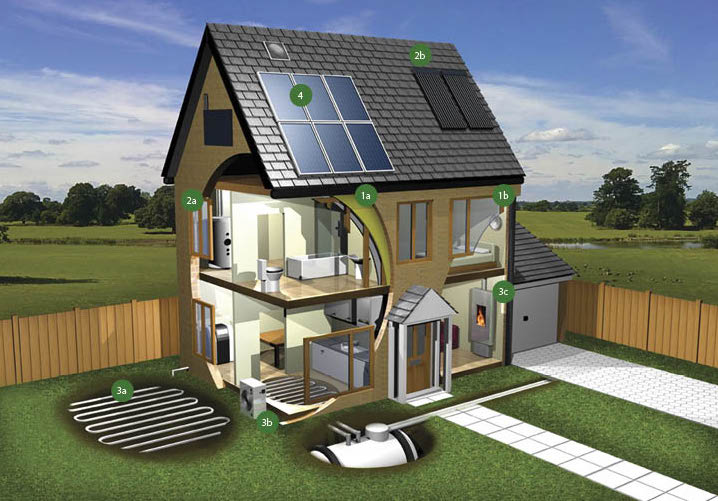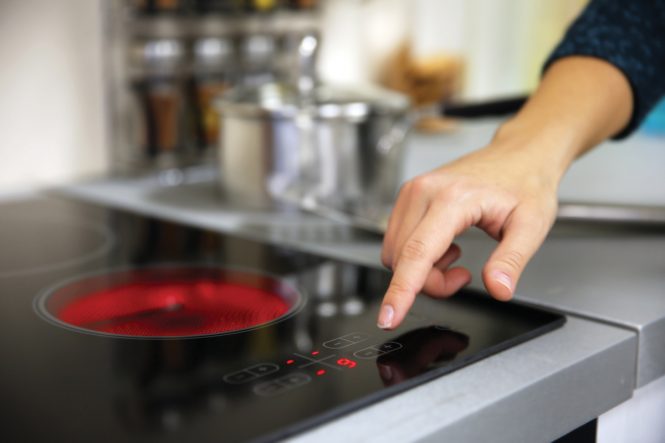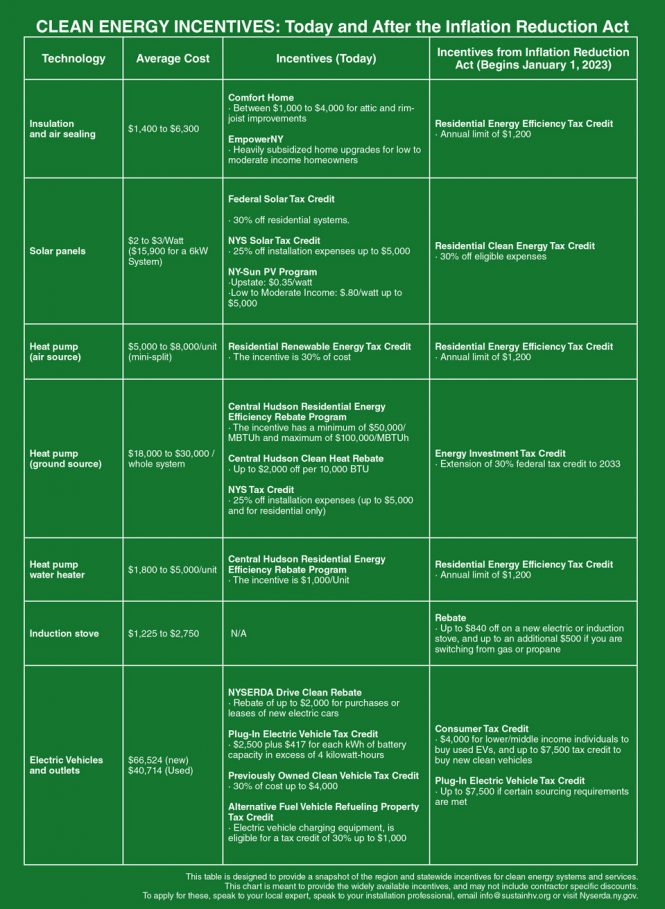Making Your Home Renewable
By Ben Eckstein | Winter 2022 | Clean Power Guide
Although every home and budget will be different, this depiction of an energy-efficient home is an effective snapshot of the upgrades and sustainable measures addressed in this article.
Ensuring your home is sealed and insulated from outside elements is, for many, going to be the first, and possibly most expensive step of your journey. Installing insulation (1a) and air-sealing measures (1b) such as energy-efficient windows will keep you cool in the summer and warm in the winter, and reduce the energy needed to do so.
Hot Water could come from an electric water heater (2a), instant water heater, or even utilize the sun through a solar thermal system (2b).
Supplying heat or AC to the home can be expensive and often involves burning fuel in the home. Making sure that this system is as clean and efficient as possible will help reduce the amount of energy needed to heat and cool your home, and will reduce the cost compared to traditional electric heat. This can take the form of ground source heat pumps (3a), air source heat pumps (3b), and can even be used in tandem with ancillary heat such as a wood furnace (3c).
Solar panels (4) are installed on your roof, and are a great way to power your home with clean renewable energy. For those who find solar too expensive or inconvenient, community solar is a great choice.
Today, homeowners all over New York state are hearing about how various state programs and policies will be affecting their lives. Many criticize this focus on the homeowner, saying that it should be the responsibility of the state and the corporations that many see as responsible for the increased amount of carbon dioxide in the atmosphere.
The sustainable transition that New York State is experiencing, however, will not discriminate between current and previous emitters of carbon dioxide. Between the acronyms, technical language, and companies selling products, it can be confusing for homeowners to identify the things that are truly important for them to help by transitioning their own homes.
Here is a snapshot of the important technologies, their costs, and the incentives that will help you transition your own home. This transition should take place based on your time and budget, and the table on the next page presents opportunities and incentives that are available now, and after the implementation of the Inflation Reduction Act (IRA) in 2023. These incentives are subject to change, so there may be additional incentives to take advantage of.
Insulation and Air Sealing
One of the costlier upgrades to the home, insulation and air sealing can be the single most energy-efficient and cost-effective home upgrade. Ensuring your home is equipped for the winter temperatures by sealing up a home that is leaking heat will not only keep your home warmer, but will save you money, as your heating system will not work as hard to produce warm temperatures.
Solar Power
Residential Solar
Many see solar panels as the quickest way to power your home with renewable energy. While it may be simple to do, this can often be expensive and almost impossible to do if you are a renter. Other options include Community Solar or community choice aggregation (see below for details on both).
Community Solar
Community Solar involves a large array of solar panels, typically at an offsite location that allows homeowners to access solar clean power without installing panels on their homes. Energy is still delivered through their regular electric provider while the power produced from the community solar array is fed directly back to the electric grid and customers receive credits on their electricity bill.
Community Choice Aggregation
Community Choice Aggregation (CCA) allows local elected officials to choose where the energy comes from for their community. It’s a program to purchase power in bulk for virtually all homes and small businesses within the participating jurisdiction. This is an easy way to sign many homes up for solar power in an area. For example, the Ulster County municipality of Marbletown has implemented a local CCA project, opting in all residents to be supplied by solar. This is all in pursuit of their goal to become 100 percent renewable.
Heat Pump
Air Source Heat Pump
By taking the outside air and converting the temperature to be either hotter or colder, air source heat pumps are able to use a pre-existing duct system (ducted), or be placed strategically in individual rooms (mini-splits). This is similar to an air conditioning unit, but with the ability to produce heat. The use of this can be flexible, as mini-splits are able to be used around the whole house, or in a single drafty room.
Ground Source Heat Pump
Also known as geothermal, this takes the heat in the ground and extracts it to flow into the home. Although this option is more expensive, it often lasts longer than its air-fueled counterpart.
Heat Pump Hot Water Heater
Similar to an air source heat pump, a heat pump water heater takes outside air, converts it into heat, and uses that to make hot water in the home. This is more advantageous than a traditional hot water heater as it is not burning fuel in the home, and uses electricity to make hot water. A heat pump water heater can come with a tank or be tankless, and can be combined with an existing heat pump to use the excess heat to produce hot water even more efficiently.
Induction Stove

Induction stoves are more efficient than both traditional electric and gas-powered ones—five to ten percent more efficient than conventional electric and three times more efficient than gas.
A relatively newer technology, these stoves use induction technology, which employs a magnetic field to generate and transfer heat directly onto your cooking surface. These stoves are more efficient than both traditional electric and gas-powered ones. While some may miss the presence of a flame, the induction stove helps cook with a more even and cleaner source of heat.
Electric Vehicles and Outlets
Electric vehicles (EVs) will be an important factor to the achievement of New York’s climate goals. Whether a battery electric vehicle (BEV) or a hybrid (HEV), EVs have become more affordable and accessible particularly in recent years. EVs are unique in that even if they are affordable and accessible, that does not mean there are EV chargers that are easily accessed.
EV chargers come in three different levels. Level 1 uses a 120-volt outlet, which is a standard outlet found in any home. Due to its slow charging speed, a Level 2 charger is often recommended, and is very easy to install with the help of an electrician. By installing a 240-volt outlet, a Level 2 charger can be used to charge your vehicle in a matter of hours.
Creating your own Renewable Action Plan
For those who want to get started but are unsure about the first steps, a 100 percent renewable planning framework exists to help homeowners think about and plan their energy future. This will help residents and businesses start to plot their transition away from fossil fuels. By guiding local residents through a simple 10-step process, homeowners and renters alike will be better equipped to take action based on your time and your budget. Creating a plan will allow consumers to connect with free energy coaches who are familiar with the technologies, opportunities, and incentives that will help you through this transition.
(Sustainhv.org/100-renewable-marbletown)
For more information on state programs and incentives, visit Nyserda.ny.gov/all-programs.

